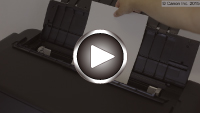Loading Paper in the Top Feed
You can load multiple sheets of paper of the same type and size in the top feed.
 Important
Important
- If you cut plain paper into small size such as 4" x 6" (10 x 15 cm) or 5" x 7" (13 x 18 cm) to perform trial print, it can cause paper jams.
 Note
Note
-
The top feed accepts the following page sizes.
- A5, A4, A3, A3+, A2
- B5, B4, B3
- Letter, Legal
- 4" x 6" (10 x 15 cm), 5" x 7" (13 x 18 cm), 8" x 10" (20 x 25 cm), 10" x 12" (25 x 30 cm), 11" x 17" (28 x 43 cm), 14" x 17" (36 x 43 cm), 17" x 22" (43 x 56 cm)
- 8.27 x 23.39 inches (210 x 594 mm)
-
We recommend Canon genuine photo paper for printing photos.
For details on the Canon genuine paper, see Media Types You Can Use.
-
You can use general copy paper or Canon Red Label Superior/Canon Océ Office Colour Paper.
For the page size and paper weight you can use for this printer, see Media Types You Can Use.
- Print in an environment (temperature and humidity) suitable to the paper in use. For the temperature and humidity conditions of Canon genuine papers, refer to the paper's packaging or the supplied instructions.
-
Prepare paper.
Align the edges of paper. If paper is curled, flatten it.
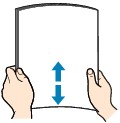
 Note
Note- Align the edges of paper neatly before loading. Loading paper without aligning the edges may cause paper jams.
-
If paper is curled, hold the curled corners and gently bend them in the opposite direction until the paper becomes completely flat.
For details on how to flatten curled paper, see "Load the paper after correcting its curl." in Paper Is Smudged / Printed Surface Is Scratched.
- When using Photo Paper Plus Semi-gloss, even if the sheet is curled, load one sheet at a time as it is. If you roll up this paper to flatten, this may cause cracks on the surface of the paper and reduce the print quality.
-
Open the paper support (A) of the top feed, then extend the paper support extension (B).
-
Open the paper output tray (C) gently.
-
Open the output tray extension (D), then pull out the paper output support (E).
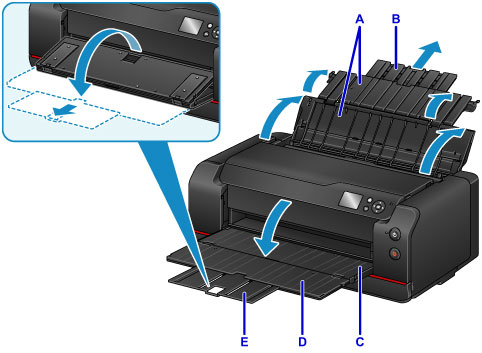
-
Open the feed slot cover (F).
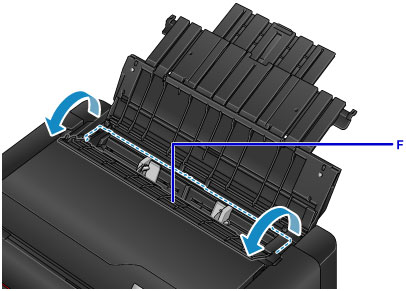
-
Slide the paper guides (G) to open them, and load the paper in the center of the top feed WITH THE PRINT SIDE FACING YOU.
-
Slide the paper guides (G) to align them with both sides of the paper stack.
Do not slide the paper guides too hard against the paper. The paper may not be fed properly.
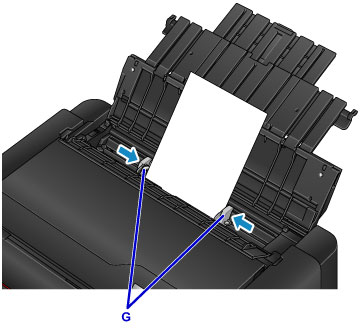
 Important
Important-
Always load paper in the portrait orientation (H). Loading paper in the landscape orientation (I) can cause paper jams.
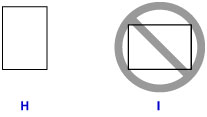
 Note
Note- Do not load sheets of paper higher than the load limit mark (J).
-
The raised parts (K) on the paper guides retract depending on the size of the loaded paper. Do not push these parts down with your finger.
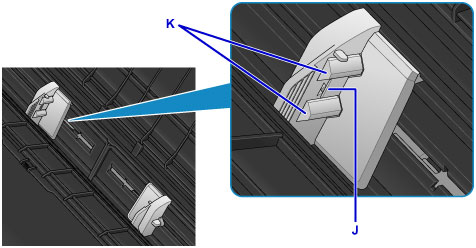
- For loading long-length paper (paper that the length is up to 47.24 inches (1200 mm)), the leading edges of paper are lifted depending on the paper weight and printouts may be misaligned. Prevent the leading edges of paper from lifting by holding the parts protruding from the tray or other ways.
-
-
Close the feed slot cover gently.
The paper information registration screen for the top feed is displayed on the LCD.
 Important
Important- If the feed slot cover is open, paper cannot be fed. Be sure to close the feed slot cover.
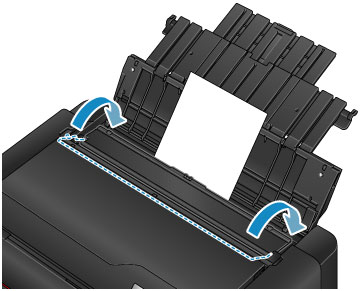
-
Select the size and type of paper loaded in the top feed at Page size and Type, select Register, then press the OK button.
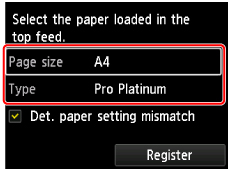
If a message is displayed on the screen, follow the directions in the message to complete registration.
 Note
Note
- When printing, select the top feed for the paper source and the size and type of the loaded paper on the print settings screen of the printer driver.
- For printing on long-length paper (paper that the length is up to 47.24 inches (1200 mm)), hold ejected paper with your hand or use the printer at the location that paper does not fall. If paper falls, the printed surface may get dirty or be damaged. If you hold paper with your hand, do not pull it forcibly while printing.

